|
 OIL SAND AND DEPLETED GAS ZONE
OIL SAND AND DEPLETED GAS ZONE
This case history shows an
unusual fluid distribution. Here we have gas over water over
oil (oil or bitumen) over another water zone, all in the
same continuous pressure regime. The oil lies under a water
zone because the oil is heavier than water OR because the
sediments that now contain water and gas were deposited
after the oil was degraded to become immoveable. In some areas,
bitumen
sits near the surface and can be mined in open pits after
the glacial till is stripped off. Where the oil zone is
deeper, it is extracted by steam assisted gravity drainage (SAGD)
or by fire flood coking. Reservoir continuity vertically and
horizontally is an important economic factor, so detailed
petrophysics in closely spaced evaluation wells is a
critical step.

Oil sands at 63 times magnification:
shaly sand (left) with Vsh > 35%,
clean sand (right) with Vsh < 5%.
Shale breaks and thick low grade
oil are unattractive targets for mining or in-situ production. In
the example below, two wells are shown that are less than 100 meters
apart. In the oil zone, the individual shale lenses are not correlatable over even this short distance. They act as baffles to
the flow of steam upward and to the flow of oil downward to the
collector wells. This example shows wells with reasonable quality
reservoir characteristics. More shale on average is less attractive;
less shale would be better. Note that these logs are on a highly
compressed vertical scale, making them harder to see than other
examples in this Handbook.
The gas zone above the oil sand is
also interesting. In the well on the left below, the gas crossover
is clearly visible, shaded red, on the density neutron logs. The
resistivity, shaded blue, is relatively high, even though the zone
is somewhat shaly on the gamma ray. Contrast this with the well on
the right, drilled 5 years later, but less than 100 meters away.
There is still crossover on the entire gas interval, but the high
resistivity covers only the top half of the zone. The lower half of
the gas zone now has low resistivity - it is wetter than before,
indicating that some of the gas has gone. Production from other
wells has partially depleted this reservoir. Crossover still exists
in the depleted zone because of residual gas. In fact, residual gas
in a depleted zone is about the same as residual gas in an invaded
zone, so unless recovery factor is extremely high, depleted gas
zones will have some crossover, if they are clean enough to show
crossover at all.
The water between the gas and oil
is called "top water" by the oil explorationist, to distinguish it
from the "bottom water" below the oil. Either or both of the gas and
top water zones may be missing in this region.
The moral of the tale is that gas
crossover can be misleading. First, prove it is gas and not bad hole
condition or sandstone on a limestone scale. Second, check that the
zone is resistive enough to still have a reasonably attractive water
saturation. Then test the zone to be sure.
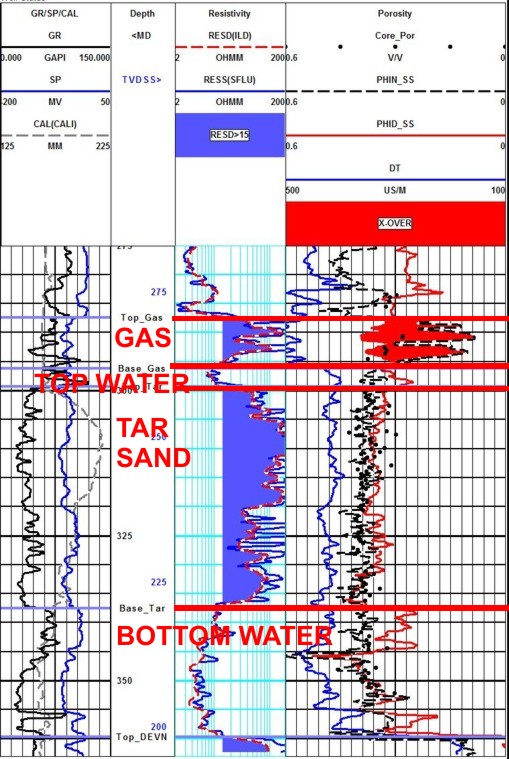 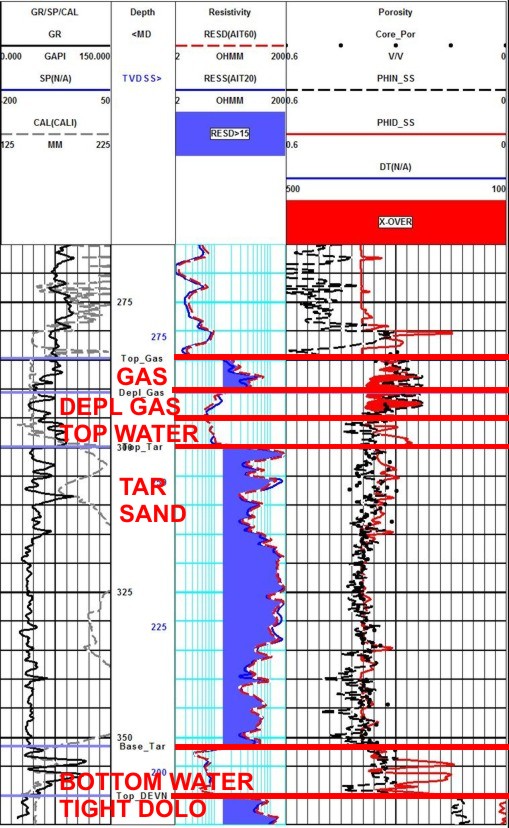
Oil sand (both wells) with gas above water (top left) and partially
depleted gas (above right).

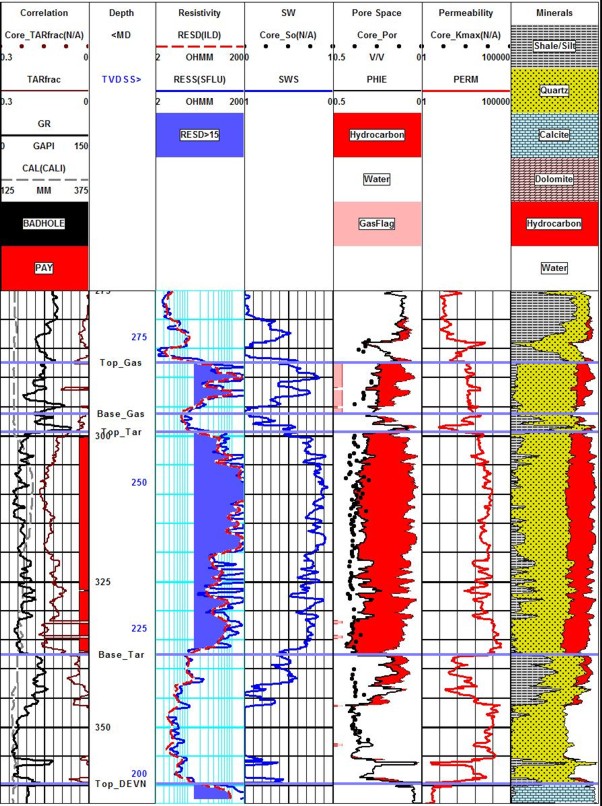 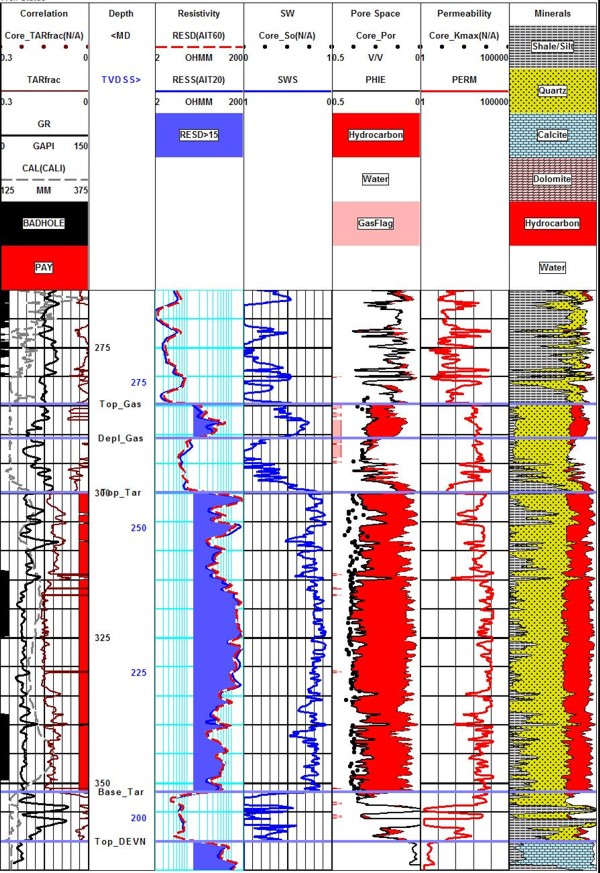
Petrophysical analysis results for gas over water over oil over
water example. Top water is thicker in the well at right due gas
depletion. Bottom water contact is tilted due to movement after oil
became immobile and before gas was trapped (horizontal original gas
water contact).

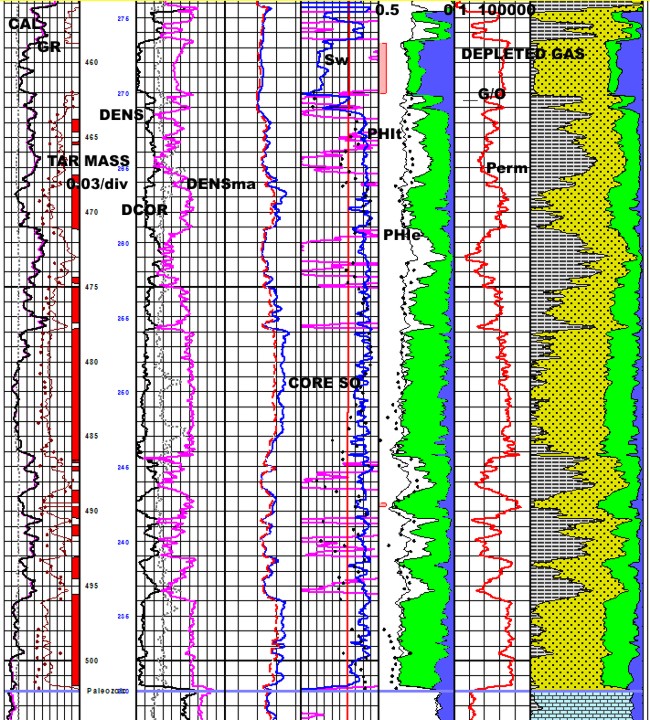
This is a different well showing the match between log analysis and
core analysis results. The porosity track shows oil in green and
water in blue with core data as black dots. The core porosity
matches log analysis total porosity (PHIt) not effective porosity (OHIe),
because the core assay is done using the Dean-Stark Method.
Core oil saturation is plotted on (1 - SW). The match is not perfect
as the SW is the effective saturation and core is based on total
porosity. However, the oil mass in Track 1 matches quite well, as
both core and log analysis methods reconcile their differences
inside the equations. A small fix to a lower RW would shift the log
curves to an even better match.
|

